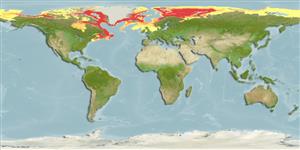Environment: milieu / climate zone / profondeur / distribution range
Écologie
marin démersal; profondeur 6 - 1750 m (Ref. 117245). Polar; 83°N - 41°N, 180°W - 180°E
Circumarctic (Ref. 11954). Northeast Atlantic: northeast Greenland, Jan Mayen Island, northern coasts of Iceland, Faroes-Shetland slope, northern part of Barents Sea, White Sea and around Spitsbergen. Northwest Atlantic: Arctic Canada to Labrador and Gulf of St. Lawrence; possibly to Cape Cod in Massachusetts, USA (Ref. 7251). Arctic Ocean: Kara Sea, western part of Laptev Sea, Beaufort Sea and Arctic Canada. Subspecies(?) Lycodes pallidus marisalbi in White Sea only (Ref. 4695).
Taille / Poids / Âge
Maturité: Lm ? range ? - ? cm
Max length : 26.0 cm TL mâle / non sexé; (Ref. 4695); common length : 18.0 cm TL mâle / non sexé; (Ref. 4695)
Description synthétique
Clés d'identification | Morphologie | Morphométrie
Vertèbres: 90 - 93. Pelvic fins small (Ref. 4695). Young with pale, yellowish-brown body, with 6-8 light and narrow cross bands which are more distinct on the dorsal fin; larger individuals lose the bands, becoming more or less uniformly colored (Ref. 4695).
Body shape (shape guide): elongated.
Found on muddy bottoms (Ref. 4695). Benthic (Ref. 58426). Feeds mostly on endobenthic prey such as small bivalves, polychaetes and small crustaceans in addition to detritus. It seems to get the bulk of its food by burrowing in the sediment (Ref. 13532). Ripe females recorded in September in the Kara Sea (Ref. 4695). Minimum depth from Ref. 58018.
Life cycle and mating behavior
Maturité | Reproduction | Frai | Œufs | Fécondité | Larves
Anderson, M.E., 1994. Systematics and osteology of the Zoarcidae (Teleostei: Perciformes). Ichthyol. Bull. J.L.B. Smith Inst. Ichthyol. 60:120 p. (Ref. 11954)
Statut dans la liste rouge de l'IUCN (Ref. 130435: Version 2025-1)
Menace pour l'homme
Harmless
Utilisations par l'homme
Outils
Articles particuliers
Télécharger en XML
Sources Internet
Estimates based on models
Preferred temperature (Réf.
123201): -0.9 - 4.9, mean 0.8 °C (based on 2262 cells).
Phylogenetic diversity index (Réf.
82804): PD
50 = 0.5000 [Uniqueness, from 0.5 = low to 2.0 = high].
Bayesian length-weight: a=0.00269 (0.00141 - 0.00516), b=3.22 (3.06 - 3.38), in cm total length, based on LWR estimates for this Genus-body shape (Ref.
93245).
Niveau trophique (Réf.
69278): 3.1 ±0.36 se; based on food items.
Résilience (Réf.
120179): Milieu, temps minimum de doublement de population : 1,4 à 4,4 années (Preliminary K or Fecundity.).
Fishing Vulnerability (Ref.
59153): Low vulnerability (16 of 100).
🛈
